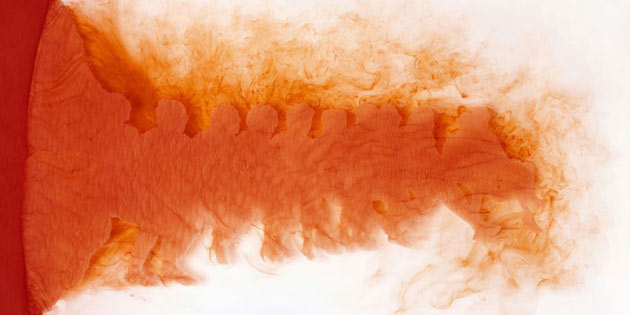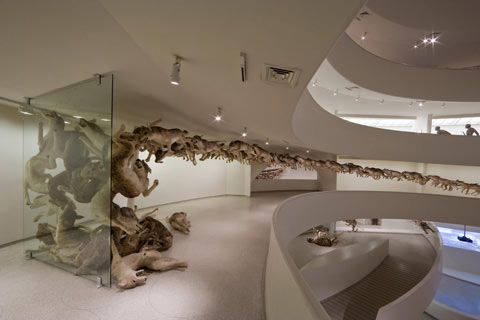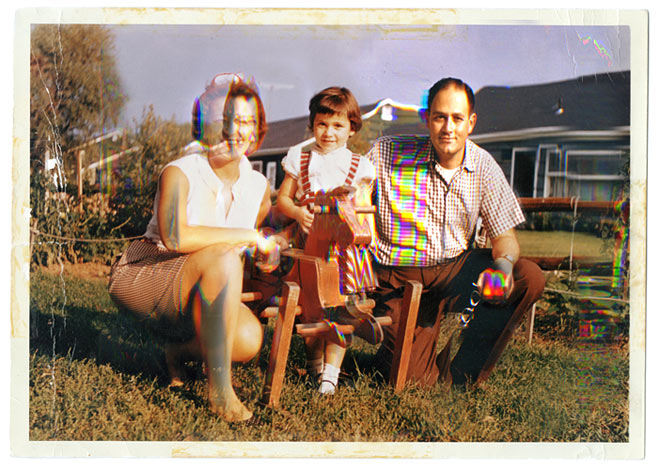
Facebook users can spread emotions to their online connections just by posting a written message, or status update, that’s positive or negative, says a psychologist who works for the wildly successful social network.
This finding challenges the idea that emotions get passed from one person to another via vocal cues, such as rising or falling tone, or by a listener unconsciously imitating a talker’s body language, said Adam Kramer on January 27 at the annual meeting of the Society for Personality and Social Psychology. Kramer works at Facebook’s headquarters in Palo Alto, Calif.
“It’s time to rethink how emotional contagion works, since vocal cues and mimicry aren’t needed,” Kramer said. “Facebook users’ emotion leaks into the emotional worlds of their friends.”
{ ScienceNews | Continue reading }
psychology, relationships, social networks |
January 31st, 2012

Nurturing a child early in life may help him or her develop a larger hippocampus, the brain region important for learning, memory and stress responses, a new study shows.
{ Cosmos | Continue reading }
Previous animal research showed that early maternal support has a positive effect on a young rat’s hippocampal growth, production of brain cells and ability to deal with stress. Studies in human children, on the other hand, found a connection between early social experiences and the volume of the amygdala, which helps regulate the processing and memory of emotional reactions. Numerous studies also have found that children raised in a nurturing environment typically do better in school and are more emotionally developed than their non-nurtured peers.
Brain images have now revealed that a mother’s love physically affects the volume of her child’s hippocampus. In the study, children of nurturing mothers had hippocampal volumes 10 percent larger than children whose mothers were not as nurturing. Research has suggested a link between a larger hippocampus and better memory.
{ LiveScience | Continue reading }
photo { Jeanne Buechi }
brain, kids, relationships |
January 31st, 2012

A meta-analysis done by the Centre for Addiction and Mental Health (CAMH) into the relationship between alcohol consumption and heart disease provides new insight into the long-held belief that drinking a glass of red wine a day can help protect against heart disease.
“It’s complicated,” says Dr. Juergen Rehm. “While a cardioprotective association between alcohol use and ischaemic heart disease exists, it cannot be assumed for all drinkers, even at low levels of intake,” says Dr. Rehm.
Ischaemic heart disease is a common cause of illness and death in the Western world. Symptoms are angina, heart pain, and heart failure. (…)
“Even one drink a day increases risk of breast cancer, for example,” says Dr. Rehm. “However, with as little as one drink a day, the net effect on mortality is still beneficial. After this, the net risk increases with every drink.”
“If someone binge drinks even once a month, any health benefits from light to moderate drinking disappear.” Binge drinking is defined more than four drinks on one occasion for women, and more than five for men.
{ EurekAlert | Continue reading }
food, drinks, restaurants, health |
January 31st, 2012

Deep down on the bottom of the Baltic Sea, Swedish treasure hunters think they have made the find of a lifetime. The problem is, they’re not exactly sure what it is they’ve uncovered. Out searching for shipwrecks at a secret location between Sweden and Finland, the deep-sea salvage company Ocean Explorer captured an incredible image more than 80 meters below the water’s surface.
“I have been doing this for nearly 20 years so I have a seen a few objects on the bottom, but nothing like this,” said Lindberg.
Using side-scan sonar, the team found a 60-meter diameter cylinder-shaped object, with a rigid tail 400 meters long. The imaging technique involves pulling a sonar “towfish” — that essentially looks sideways underwater - behind a boat, where it creates sound echoes to map the sea floor below. On another pass over the object, the sonar showed a second disc-like shape 200 meters away.
Lindberg’s team believe they are too big to have fallen off a ship or be part of a wreck. (…)
The reliability of one-side scan sonar images is one of his main concerns, making it difficult to determine if the object is a natural geological formation or something different altogether. (…)
Odyssey Marine Exploration — a company made up of researchers, scientists, technicians and archaeologists — have at least 6,300 shipwrecks in their database that they are looking to find. Mark Gordon, president of Odyssey, says at least 100 ships on their watch-list are known to have values in excess of $50 million dollars.
“When you think about the fact until the mid 20th century, the only way to transport wealth was on the oceans and a lot of ships were lost, it adds up to a formula where we have billions of dollars worth of interesting and valuable things on the sea floor,” he said.
{ CNN | Continue reading }
mystery and paranormal, transportation |
January 31st, 2012

The young can’t advance because everywhere they find my complacent generation is in situ. Thus the only way of solving the problem is to make everyone of a certain age, say over 50, walk the plank. (…)
The choice boils down to whether it’s better for people to have a decade at the beginning or at the end of their careers where they are demoralised and underemployed. The answer is easy: surely it is better to be more active at the beginning.
To have people idle at a time when they are full of energy and their grey-cell count is at a maximum is a shocking waste. And in any case, my generation has had it very good for much too long. We bought houses when they were still just about affordable. We had free education and pensions. It’s all been jolly nice, and I’ve enjoyed it a lot. Now is the time to start to pay.
{ Financial Times | Continue reading }
photo { Brooke Nipar }
economics, ideas |
January 30th, 2012
ideas, photogs |
January 30th, 2012
photogs, visual design |
January 30th, 2012

In fact, it has become pretty clear that deciphering consciousness will definitely be more difficult than describing the dynamics of DNA. Crick himself spent more than two decades attempting to unravel the consciousness riddle, working on it doggedly until his death in 2004. His collaborator, neuroscientist Christof Koch of Caltech, continues their work even today, just as dozens of other scientists pursue a similar agenda — to identify the biological processes that constitute consciousness and to explain how and why those processes produce the subjective sense of persistent identity, the self-awareness and unity of experience, and the “awareness of self-awareness” that scientists and philosophers have long wondered about, debated and sometimes even claimed to explain.
So far, no one has succeeded to anyone else’s satisfaction. Yes, there have been advances: Understanding how the brain processes information. Locating, within various parts of the brain, the neural activity that accompanies certain conscious perceptions. Appreciating the fine distinctions between awareness, attention and subjective impressions. But yet with all this progress, the consciousness problem remains popular on lists of problems that might never be solved.
Perhaps that’s because the consciousness problem is inherently similar to another famous problem that actually has been proved unsolvable: finding a self-consistent set of axioms for deducing all of mathematics. As the Austrian logician Kurt Gödel proved eight decades ago, no such axiomatic system is possible; any system as complicated as arithmetic contains true statements that cannot be proved within the system.
Gödel’s proof emerged from deep insights into the self-referential nature of mathematical statements. He showed how a system referring to itself creates paradoxes that cannot be logically resolved — and so certain questions cannot in principle be answered.
{ ScienceNews | Continue reading }
photo { Kim Boske }
ideas, neurosciences, psychology |
January 30th, 2012

The key to understanding the evolution of the euro is to observe and analyse what the Europeans do rather than what they say. They have resolved all of the many crises that have threatened the European integration project throughout its history of more than half a century. (…) At each key stage of the current crisis, they have in fact done whatever is necessary to avoid collapse. (…)
Crisis resolution cheaper than euro collapse.
{ Vox | Continue reading }
photo { Charlie Grosso }
economics |
January 30th, 2012

This article examines the possibility that romantic love (with intensity, engagement, and sexual interest) can exist in long-term relationships. A review of taxonomies, theory, and research suggests that romantic love, without the obsession component typical of early stage romantic love, can and does exist in long-term marriages, and is associated with marital satisfaction, well-being, and high self-esteem.
Supporting the separate roles of romantic love and obsession in long-term relationships, an analysis of a moderately large data set of community couples identified independent latent factors for romantic love and obsession and a subsample of individuals reporting very high levels of romantic love (but not obsession) even after controlling for social desirability. Finally, a meta-analysis of 25 relevant studies found that in long- and short-term relationships, romantic love (without obsession) was strongly associated with relationship satisfaction; but obsession was negatively correlated with it in long-term and positively in short-term relationships.
{ Review of General Psychology | Continue reading | PDF }
photo { Herb Ritts }
psychology, relationships |
January 27th, 2012

The email might contain “privileged, confidential and/or proprietary information,” they are told. If it landed in their inbox by error, they are strictly prohibited from “any use, distribution, copying or disclosure to another person.” And in such case, “you should destroy this message and kindly notify the sender by reply email.” (…)
Email disclaimers, those wordy notices at the end of emails from lawyers, bankers, analysts, consultants, publicists, tax advisers and even government employees, have become ubiquitous—so much so that many recipients, and even senders, are questioning their purpose. (…)
Emails often now include automatic digital signatures with a sender’s contact information or witty sayings, pleas to save trees and not print them, fancy logos and apologies for grammatical errors spawned by using a touch screen. (…)
Some lawyers say the disclaimers have value, alerting someone who receives confidential, proprietary, or legally privileged information by accident that they don’t have permission to take advantage of it.
Others, including lawyers whose email messages are laden with them, say the disclaimers are for the most part unenforceable. They argue that they don’t create any kind of a contract between sender and recipient merely because they land in the recipient’s inbox.
It’s largely untested whether email disclaimers can hold up in court and at least one ruling on the matter was mixed.
Boilerplate language attached to every email dilutes the intention, some say. For instance, when every message from a sender’s account is tagged with “privileged and confidential,” it might make it difficult to convince a judge that any one email is more private than another.
{ WSJ | Continue reading }
law, technology |
January 27th, 2012

Of the 110 sword swallowers queried, 46 responded and agreed to have their results reported. (…)
The most common medical complaint: a sore throat, or “sword throat” as it’s known in the business, which typically occurred while they were still learning, after frequent performances or from stunts involving multiple or odd-shaped swords. Some experienced lower chest pains, often lasting for days, which could be relieved by not swallowing any swords for a few days. Sixteen mentioned intestinal bleeding and one was told a sword had “brushed” his heart. (…)
The study also revealed how swallowers learned their craft. Often practicing daily for months or years, many desensitized their gag reflexes by gradually increasing the size of objects they shoved down their throats, beginning with their finger, then spoons, paint brushes and knitting needles before moving on to the commonly used bent wire coat hanger.
Performers must learn how to align a sword with their upper esophageal sphincter, a muscular ring at the upper end of the esophagus, and how to relax muscles in the pharynx and esophagus, which usually are not under voluntary control.
Tricks used to coax a blade down the throat varied: Many performers lubricated their swords first with saliva; one performer used butter and another had to retire because of a dry mouth condition. Some performed “the drop,” in which the sword falls abruptly down the throat; some invited audience members to move the sword.
{ LiveScience | Scientific American | more }
leisure, mystery and paranormal |
January 27th, 2012

In 1925, Benito Mussolini initiated a campaign to destroy the Mafia and assert Fascist control over Sicilian life. (…) Mussolini appointed Cesare Mori as the Prefect of Palermo in October 1925 and granted him special powers to fight the Mafia. Mori formed a small army of policemen, carabinieri and militiamen, which went from town to town, rounding up suspects. To force suspects to surrender, they would take their families hostage, sell off their property, or publicly slaughter their livestock. By 1928, over 11,000 suspects were arrested. Confessions were sometimes extracted through beatings and torture. Some mafiosi who had been on the losing end of Mafia feuds voluntarily cooperated with prosecutors, perhaps as a way of obtaining protection and revenge. (…)
Mori’s campaign ended in June 1929 when Mussolini recalled him to Rome. Although he did not permanently crush the Mafia as the Fascist press proclaimed, his campaign was nonetheless very successful at suppressing it. As the Mafia informant Antonino Calderone reminisced: “After the war the mafia hardly existed anymore. The Sicilian Families had all been broken up.”
Sicily’s murder rate sharply declined. Many mafiosi fled to the United States. Among these were Carlo Gambino and Joseph Bonanno, who would go on to become powerful Mafia bosses in New York City.
{ Wikipedia | Continue reading }
flashback |
January 27th, 2012

Another time I bought security footage of these killers. Before they went out to basically kill people, they went to a Popeyes Chicken. I went to that location and let’s just say I bought $1000 worth of chicken. […]
This aggregation thing, it’s a bad ethos. If people are not producing original journalism, why should people pay attention? Overtime, they won’t. But by then the real institutions are going to be gone, and you just don’t build those overnight. Everyone’s going to be locked into these aggregators until they get bored and realize they don’t serve their interest, and they’re going to look around for the real newspapers and the real newsmakers, and they’re not going to be there anymore.
{ Kerry Burke/The Awl | Continue reading }
artwork { Berni Searle }
experience, media |
January 26th, 2012

Microwave Massacre is a 1983 dark comedy/horror film directed by Wayne Berwick. (…)
After coming home drunk one night and getting into an argument with his wife May, Donald loses his temper and bludgeons her to death with a large pepper grinder. He wakes up the next day with a bad hangover, no memory of the night before, and a growling stomach. He discovers May’s corpse in the microwave and after the initial wave of horror passes, he starts to take it in stride, telling his co-workers that he and May separated. After work, he cuts up May’s body and stores it in foil wrap in the fridge.
Looking for a midnight snack one night, Donald unintentionally takes a few bites of May’s hand, and after the initial wave of horror passes, he realizes it’s the best thing he’s ever eaten. He even brings some to work with him and shares it with Phillip and Roosevelt, who concur. He soon starts picking up hookers and using them for meat in his recipes. (…)
Donald’s lunches continue to be a hit with his friends, and he decides to cater an outing to a wrestling match with a new recipe he calls “Peking chick.” When Roosevelt and Phillip show up to pick up Donald, they discover him dead on the floor of a heart attack, and some body parts in the microwave. They leave in horror and disgust, realizing what Donald had been serving them.
{ Wikipedia | Continue reading }
photo { Glenn Glasser }
food, drinks, restaurants, gross, haha, photogs, showbiz, weirdos |
January 26th, 2012

To determine “how public figures realize creative forms of apologetic speech in order to minimize their responsibility for misdeeds,” Kampf examined 354 conditional apologies made by Israeli public figures, organizations, or institutions between 1997 and 2004, breaking them down into specific categories and sub-categories. (…)
After making racist remarks about Ethiopian immigrants, writer Samuel Shnitzer replied with a classic “if” statement: “If someone was hurt by the column I wrote, I am very sorry about that.” Ariel Sharon’s 2002 statement concerning the deaths of Palestinian civilians during a military campaign managed to include both an “if” and a “but”: “The Israeli Defense Force is sorry if civilians were injured, but not for the successful operation.”
As Kampf pointed out, this delicate wordplay is important to politicians who want to keep their jobs. But it’s even more crucial to business executives who, if they truly accepted responsibility, might end up in jail. A research team led by the University of Ulster’s Owen Hargie analyzed the testimony of four CEOs of financial institutions before a committee of the British Parliament in 2009 and noted a similar pattern of obfuscation.
“The main type of apology used by the senior bankers fell into the ‘I’m sorry you’re sick’ category, where the person is in effect saying that he or she has no personal responsibility for what happened, but recognizes and expresses sympathy for the person’s predicament,” the researchers write.
{ Miller-McCune | Continue reading }
photo { Stephanie Gonot }
Linguistics, psychology |
January 26th, 2012

There are basically two possible outcomes from here. First, Ben Bernanke and his gang artificially suppress interest rates for a very long period of time creating the “Japan Syndrome” in the US, which leads to rolling recessions and a general economic malaise. Or, secondly, interest rates rise back towards more normalized levels as the economy begins a real and lasting recovery. I am really hoping for the later. In either case there is a negative and sustained impact to housing going forward. The excesses that were created over the last 20 years will have to be absorbed into the system, allowing prices to return to a more normalized and sustainable level.
{ Advisor Perspectives | Continue reading }
History suggests that 2012 will see neither a big housing rebound nor a second crash. After the last housing collapse, which first bottomed out in April 1991, prices stayed almost perfectly flat for about six years.
{ Bloomberg | Continue reading }
photo { Luisa Opalesky }
economics, housing |
January 26th, 2012
There is no consensus about the symptom criteria for psychopathy, and no psychiatric or psychological organization has sanctioned a diagnosis of psychopathy itself. (…)
The Hare Psychopathy Checklist is a standard ratings tool in forensic settings to label people as psychopaths.
A study by Hare and colleague suggested that one to two percent of the US population score high enough on a screening version of the scale to be considered potential psychopaths.
According to some, there is little evidence of a cure or effective treatment for psychopathy; no medications can instill empathy, and psychopaths who undergo traditional talk therapy might become more adept at manipulating others and more likely to commit crime. (…)
According to Hare, psychopathy stems from as yet unconfirmed genetic neurological predispositions and as yet unconfirmed social factors in upbringing. A review published in 2008 indicated multiple causes, and variation in causes between individuals.
Hare also notes that some psychopaths can blend in, undetected, in a variety of surroundings, including corporate environments He has described psychopaths as “intraspecies predators.” (…)
Psychopaths are rarely psychotic.
{ Wikipedia | Continue reading }
Robert D. Hare’s Psychopathy Checklist, Revised (PCL-R) is the psycho-diagnostic tool most commonly used to assess psychopathy. (…)
▪ Glibness/superficial charm
▪ Grandiose sense of self-worth
▪ Pathological lying
▪ Cunning/manipulative
▪ Lack of remorse or guilt
▪ Shallow affect (genuine emotion is short-lived and egocentric)
▪ Callousness; lack of empathy
▪ Failure to accept responsibility for own actions
▪ Need for stimulation/proneness to boredom
▪ Parasitic lifestyle
▪ Poor behavioral control
▪ Lack of realistic long-term goals
▪ Impulsivity
▪ Irresponsibility
▪ Juvenile delinquency
▪ Early behavior problems
▪ Revocation of conditional release
▪ Promiscuous sexual behavior
▪ Many short-term marital relationships
▪ Criminal versatility
▪ Acquired behavioural sociopathy/sociological conditioning (Item 21: a newly identified trait i.e. a person relying on sociological strategies and tricks to deceive)
{ Wikipedia | Continue reading }
psychology, weirdos |
January 26th, 2012

{ Cai Guo-Qiang, Head On, 2006 | 99 life-sized replicas of wolves and glass | The wolves were produced in Quanzhou, China, from January to June of 2006. They are fabricated from painted sheepskins and stuffed with hay and metal wires, with plastic lending contour to their faces and marbles for eyes. | Deutsche Guggenheim }


{ Guggenheim Museum, New York; Guggenheim Museum, Bilbao }
animals, archives, art |
January 26th, 2012

{ The drawings of butterflies done by Vladimir Nabokov were intended for “family use.” He made these on title pages of various editions of his works as a gift to his wife and son and sometimes to other relatives. None of these drawings portray real butterflies, both the images and the names he assigns to them are his invention. | Nabokov Museum | Continue reading }
animals, books |
January 26th, 2012
























